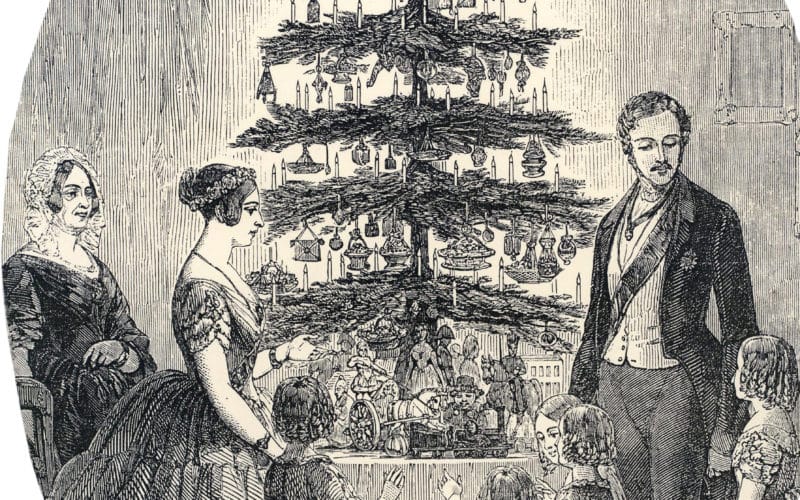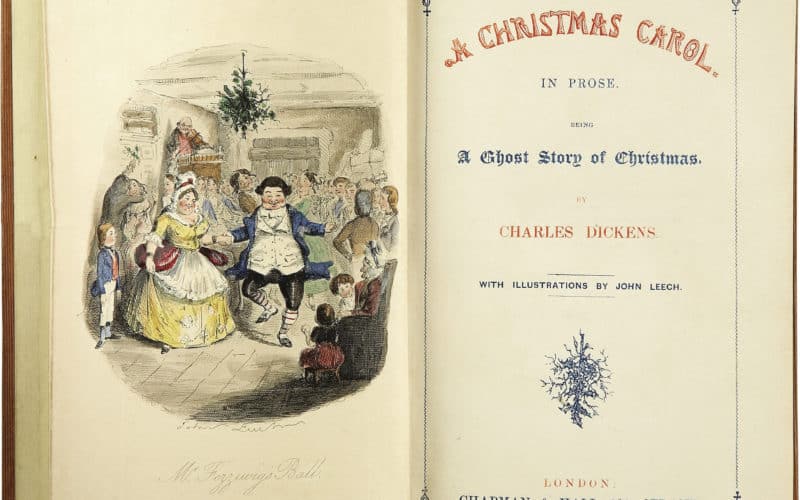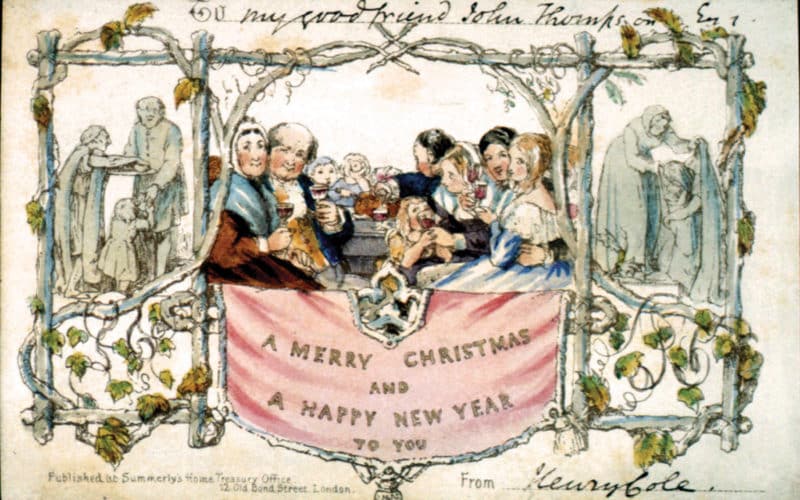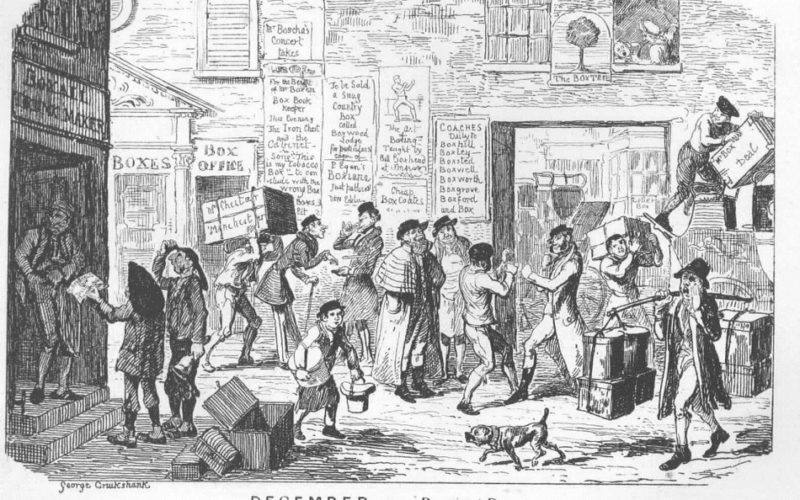
A Traditional British Christmas: Given by the Victorians
Today, when Christmas decorations begin to appear in shops as early as summer, it seems strange to think that there was a time when the holiday was barely celebrated at all. In the earliest days of Christianity in Britain, many traditions were simply carried over from Pagan beliefs, such as celebrating the holiday close to the winter solstice and the use of evergreens, which represented fertility in Paganism and everlasting life in Christianity. Other traditions that carried over during the holiday included mistletoe, the yule log, and the twelve days of Christmas.
By the Elizabethan period, there still wasn’t much of a Christmas “season” and the holiday was treated as a feast day, much as it would have been for any saint. Even with English Reformation, Christmas itself didn’t change much, though public celebrations and older Pagan-based traditions were banned for being superstitious. The Christmas feast was a chance to really celebrate with the best food and drink. Perhaps the only interruption in these celebrations was during the Commonwealth period, when Cromwell’s government ordered a cessation to the celebration of the holiday, even going so far as to order soldiers to seize any special meals being prepared for the day.
Traditional British Christmas celebrations continued to be subdued during the Georgian and Edwardian periods, but the holiday would experience a turnaround in the Victorian period. Coinciding with the beginning of Queen Victoria’s reign in 1837, Charles Dickens published a novel called The Pickwick Papers, that included an idealized version of the Christmas. In fact, the story of Christmas in Dingley Dell features an ill-tempered sexton who is visited by goblins who teach him the true meaning of the holiday, past and present. Sound familiar? Already a noted author, “A Christmas Carol” was an immediate hit when it was published in 1843, being adapted into a stage play within a year and expanding on a picturesque view of Christmas with feasts, charity, Christmas carols, spending time with loved ones, and even helped to popularise the phrase “Merry Christmas” as well as giving rise to the use of the word “Scrooge”.

In the same year that Dickens introduced A “Christmas Carol”, another Christmas tradition also made its debut. Sir Henry Cole commissioned artist John Callcott Horsley to design the first Christmas card on 1 May 1843. The card that Horsley produced had three illustrations, with the central portrait of a three-generation family raising a toast to the card’s recipient while flanked on either side with images of clothing and food being given to the poor. Cole, who was Chairman of the Arts, only had 1,000 printed and at a great cost, but it gave birth to the tradition of sending cards each year to wish happy holidays and good fortune. As the cost of postage lowered in the 1870s, the custom became more widespread. Starting in 1873, Prang and Mayor began to mass-manufacture cards for the public.
Just as Christmas cards became commercial popular during Victorian times, another popular holiday item came along that we still use today. Tom Smith, a confectioner in the 1840s, was having trouble selling his bonbons. He tried a series of gimmicks before inserting love messages into the sweet wrappers and then the cracker element after being inspired by the logs on his fireplace. Thus, the earliest Christmas crackers were born in 1847. It was first advertised as a Cosaque (or “Cossack”), but the term “cracker” quickly became more popular. Tom’s son, Walter Smith, introduced, even more, elements that we see in modern crackers, including jokes, paper crowns, and toys.
Of course, in both Dickens’s and Horsley’s portrayals of Christmas, several key elements that we have today are missing. Some holiday traditions can trace themselves to Queen Victoria’s 1840 marriage to Prince Albert. Lighted Christmas trees were a part of decorations in Germany, often illuminated with wax candles. German immigrants to the United States and the United Kingdom brought the custom with them, and Albert was no different. He brought the tradition of a Christmas tree to Buckingham Palace in 1840, which was highlighted for the first time in a drawing of the Royal Family for the Illustrated London News in 1848. Even though Queen Charlotte, wife of King George III had been the first Royal to have a Christmas tree, it was the illustration that popularised the decoration with the masses. As the newspapers continued to describe the palace’s Christmas trees in subsequent years, the people quickly followed the Royal example and Christmas trees began to appear throughout Britain.

Traditional British Christmas the First Christmas Card
As mentioned previously, the hanging of greenery inside and outside of the home went back to pre-Christian Britain, and with the proliferation of Christmas trees thanks to Prince Albert, other evergreen traditions also made their way back into British homes. The uniformity and aesthetics of the evergreens became more important than they had been in the past, with families wishing to present an orderly and elegant appearance. Druids viewed mistletoe as a symbol of vitality and one belief had it that if it was brewed into a drink, it would provide a cure for infertility. The idea of mistletoe and kissing under it seems to come from Norse tradition and was possibly brought over when those cultures invaded England. The use of the plant as a symbol fell out when Christianity became the dominant religion, as the hanging of mistletoe was viewed as a Pagan superstition.
How it came back into use during the Victorian period seems unclear, but authors Washington Irving and Charles Dickens included mentions of it in their works, the latter most notably in The Pickwick Papers. Mistletoe was a key ingredient in a “kissing ball” or “kissing bough”. Kissing boughs were typically spherical and included ivy, holly, berries, ribbons, and even a miniature nativity in some cases. One tradition holds that, for every kiss under the mistletoe, a berry was removed until there were none left. Some superstitions held that those who kissed under it were blessed with good luck, but those who failed to do so would have bad luck.
Traditional British Christmas one tradition that was revived during the Victorian period was the singing of Christmas carols. Christmas carols are as old as Roman times and existed in Britain as early as the 13th century. English language carols first appeared in 1425 in the works of John Awdlay, who mentions groups of “wassailers” singing carols from house to house. However, as with many Christmas traditions, the singing of carols went out with many other Puritan bans on Christmas celebrations under Cromwell. However, the post-Puritan carols focused mostly on feasting and merriment more than religion, though a couple songs that saw their debut included “While Shepherds Watched Their Flocks” and “Hark the Herald”. By the 1850s, carol singing was popular again due to a combination of pianos becoming more affordable and the granting of paid holidays from work in the 1870s.
Additionally, one of the biggest stars of Christmas made his first appearance in Britain during the Victorian era. The Protestant Reformation saw many Saints’ days and celebrations fall out of practice as they were believed to be too “Catholic”. Unfortunately, this included Saint Nicholas. Nicholas had been a Greek bishop famous for his gifts to the poor, most notably three daughters to whom he provided dowries so they would not become prostitutes. His legend grew such that he became Father Christmas in Britain by the 16th century, typically pictured as a large man with flowing green or red robes, but this debut was just in time for Nicholas’s feast day to be forgotten with the rest. Father Christmas saw a brief resurgence during the English Civil War and Commonwealth periods as a Royalist symbol of rebellion, pairing the figure with notions of the Church and King prior to Cromwell, but this did not last following the Restoration.
Father Christmas’s reappearance is due, in part, to “A Christmas Carol’s” Ghost of Christmas Present bearing a strikingly similar look. Dickens described him as such:
“It was clothed in one simple green robe, or mantle, bordered with white fur. This garment hung so loosely on the figure, that its capacious breast was bare as if disdaining to be warded or concealed by any artifice. Its feet, observable beneath the ample folds of the garment, were also bare; and on its head, it wore no other covering than a holly wreath, set here and there with shining icicles. Its dark brown curls were long and free; free as its genial face, its sparkling eye, its open hand, its cheery voice, its unconstrained demeanor, and its joyful air. Girded round its middle was an antique scabbard, but no sword was in it, and the ancient sheath was eaten up with rust.
Even before Dickens helped to promote the image of Father Christmas again, Thomas Harvey’s “The Book of Christmas” brought the holiday figure back and described him as riding a goat, much different from the reindeer that we imagine today. Harvey’s Father Christmas was also more about merriment than religion, a theme that would continue to grow as time went on and he became even more of a secular figure associated with joy and gift-giving. This version of Father Christmas would continue to appear in folk plays for the remainder of the century, varying in appearance according to regional customs and depictions.
Meanwhile, on the other side of the Atlantic, Saint Nicholas’s legend came to America with Dutch settlers. Known as Sinterklaas, the name later changed to Santa Claus and this version of Father Christmas began to make his way back to Europe in the 1850s. In 1853, A “Visit from Saint Nicholas”, which so cemented the modern image of Santa Claus in America, was published in Britain. The 1854 publication in the UK of the American novel “The Christmas Stocking”, further popularised the image of Santa Claus and hanging stockings with British children. These two works helped to transform Father Christmas to resemble his American counterpart even more, with Father Christmas’s robes changing from green to red and leaving gifts in stockings. Stockings then replaced the old tradition of gifts being left in shoes. By the end of the 19th century, the two were practically indistinguishable, though the name Father Christmas remained dominant over Santa Claus.

One Christmas tradition that actually originated during Queen Victoria’s reign is that of Boxing Day. While the idea of giving a “Christmas box” to servants seems to go back to the 17th Century and was even mentioned in Samuel Pepys’ Diary. At this time, it was customary for the servant to have to serve their employers on Christmas day, and then would be permitted to go home to their own families the day after, often with a Christmas box of gifts and goodies from their employers. However, this custom did not appear to become a widespread tradition until the 1830s, with the Oxford English Dictionary defining it as “the first weekday after Christmas-day, observed as a holiday on which postmen, errand boys, and servants of various kinds receive a Christmas-box.” In 1871, Boxing Day became a national holiday in England, Wales, Ireland, and Canada.
Traditional British Christmas many of these traditions that either began during the Victorian era or came back into prominence remain with us today. We hang both real and fake evergreens and Christmas trees often lit with electric lights rather than candles that come in traditional white or a variety of colors. We continue to sing the old carols, sometimes joined with accompaniment from a stereo or iPod more than a piano. We take our children to visit Father Christmas in a department store and have a photo taken. Instead of providing servants with gifts, we use Boxing Day to go shopping or watch a football match as we finish off the leftovers from Christmas day. You’ll still find people kissing under the mistletoe and families gathering in their homes, glad to spend the holiday together. Though many of these traditions may have changed since the 19th Century, the impact of the Victorians on Christmas is still felt today.

